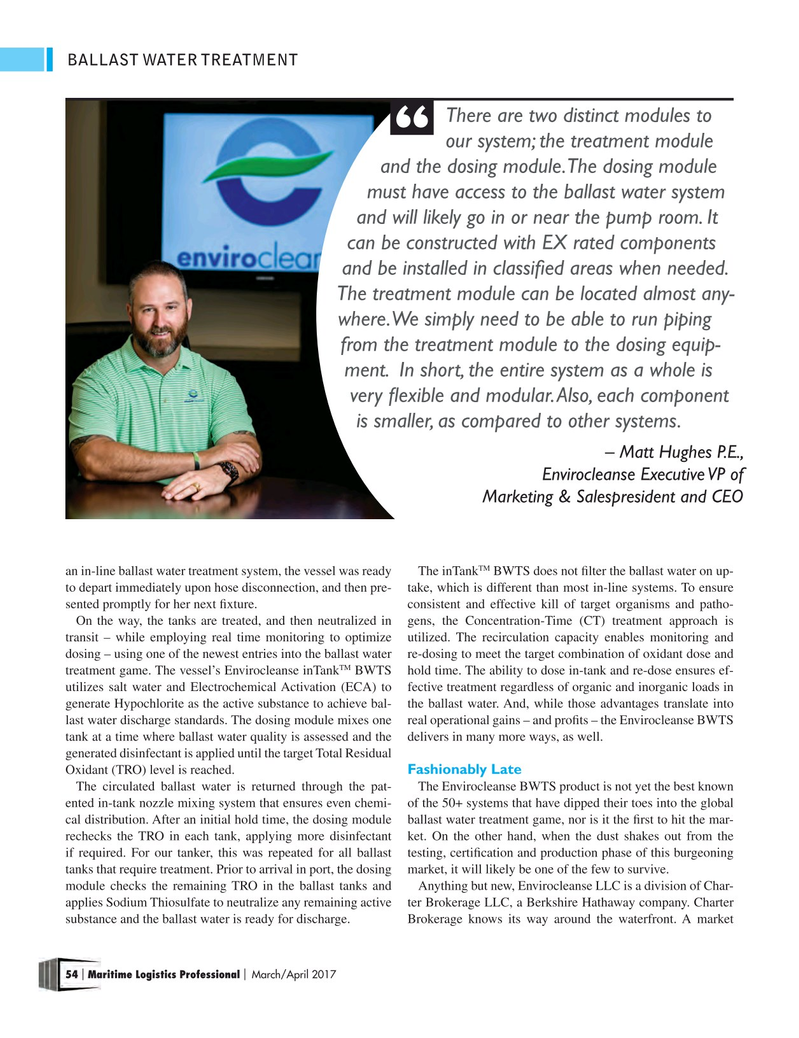
Page 54: of Maritime Logistics Professional Magazine (Mar/Apr 2017)
IT & SOFTWARE
Read this page in Pdf, Flash or Html5 edition of Mar/Apr 2017 Maritime Logistics Professional Magazine
BALLAST WATER TREATMENT
There are two distinct modules to our system; the treatment module and the dosing module. The dosing module must have access to the ballast water system and will likely go in or near the pump room. It can be constructed with EX rated components and be installed in classi? ed areas when needed.
The treatment module can be located almost any- where. We simply need to be able to run piping from the treatment module to the dosing equip- ment. In short, the entire system as a whole is very ? exible and modular. Also, each component is smaller, as compared to other systems.
– Matt Hughes P.E.,
Envirocleanse Executive VP of
Marketing & Salespresident and CEO
TM an in-line ballast water treatment system, the vessel was ready The inTank BWTS does not ? lter the ballast water on up- to depart immediately upon hose disconnection, and then pre- take, which is different than most in-line systems. To ensure sented promptly for her next ? xture. consistent and effective kill of target organisms and patho-
On the way, the tanks are treated, and then neutralized in gens, the Concentration-Time (CT) treatment approach is transit – while employing real time monitoring to optimize utilized. The recirculation capacity enables monitoring and dosing – using one of the newest entries into the ballast water re-dosing to meet the target combination of oxidant dose and
TM treatment game. The vessel’s Envirocleanse inTank BWTS hold time. The ability to dose in-tank and re-dose ensures ef- utilizes salt water and Electrochemical Activation (ECA) to fective treatment regardless of organic and inorganic loads in generate Hypochlorite as the active substance to achieve bal- the ballast water. And, while those advantages translate into last water discharge standards. The dosing module mixes one real operational gains – and pro? ts – the Envirocleanse BWTS tank at a time where ballast water quality is assessed and the delivers in many more ways, as well.
generated disinfectant is applied until the target Total Residual
Oxidant (TRO) level is reached. Fashionably Late
The circulated ballast water is returned through the pat- The Envirocleanse BWTS product is not yet the best known ented in-tank nozzle mixing system that ensures even chemi- of the 50+ systems that have dipped their toes into the global cal distribution. After an initial hold time, the dosing module ballast water treatment game, nor is it the ? rst to hit the mar- rechecks the TRO in each tank, applying more disinfectant ket. On the other hand, when the dust shakes out from the if required. For our tanker, this was repeated for all ballast testing, certi? cation and production phase of this burgeoning tanks that require treatment. Prior to arrival in port, the dosing market, it will likely be one of the few to survive.
module checks the remaining TRO in the ballast tanks and Anything but new, Envirocleanse LLC is a division of Char- applies Sodium Thiosulfate to neutralize any remaining active ter Brokerage LLC, a Berkshire Hathaway company. Charter substance and the ballast water is ready for discharge. Brokerage knows its way around the waterfront. A market 54 Maritime Logistics Professional March/April 2017 | |

 53
53

 55
55
